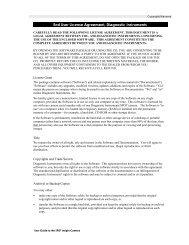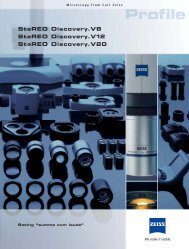optical interference filters - SPOT Imaging Solutions
optical interference filters - SPOT Imaging Solutions
optical interference filters - SPOT Imaging Solutions
Create successful ePaper yourself
Turn your PDF publications into a flip-book with our unique Google optimized e-Paper software.
At the focal point, a fluorophore absorbs two photons simultaneously.<br />
The combined energy elevates the fluorophores electrons<br />
to a higher energy level, causing it to emit a photon of lower energy<br />
when the electrons return to the ground state. For example,<br />
a 900nm laser pulse will excite at 450nm and yield fluorescence<br />
emission at ~500nm, depending on the fluorophore. This technique<br />
generally uses a combination of a shortpass dichroic mirror<br />
and an emission filter with deep blocking at the laser line. An allpurpose<br />
multiphoton short-pass dichroic mirror reflects radiation<br />
between 700 and 1000nm — the range of Ti:sapphire lasers —<br />
and transmits visible light. The emission filter must transmit fluorescence<br />
and block the laser light to more than OD6.<br />
Application Relevance<br />
A number of applications have been developed around epi-fluorescence<br />
in the research laboratory, and some are being extended to<br />
confocal and multiphoton. Example, ratio imaging can be used to<br />
quantify environmental parameters such as calcium-ion concentration,<br />
pH and molecular interactions, and it demands a unique<br />
set of <strong>filters</strong>. For example, Fura-2, a calcium dependent fluorophore,<br />
has excitation peaks at 340 and 380nm requiring excitation<br />
<strong>filters</strong> that coincide with the peaks and a dichroic mirror that<br />
reflects them. The xenon arc lamp is an ideal excitation source for<br />
epifluorescence because of its uniform intensity over the excitation<br />
range. A mercury arc source may require additional balancing <strong>filters</strong><br />
to attenuate the effects of the energy peaks.<br />
In fluorescence resonance energy transfer (FRET), energy is transferred<br />
via dipole-dipole interaction from a donor fluorophore to a<br />
nearby acceptor fluorophore. The donor emission and acceptor excitation<br />
must spectrally overlap for the transfer to happen. A standard<br />
FRET filter set consists of a donor excitation filter, a dichroic<br />
mirror and an acceptor emission filter. Separate filter sets for the<br />
donor and acceptor are recommended to verify dye presence, but<br />
most importantly, single-dye controls are needed because donor<br />
bleed-through into the acceptor emission filter is unavoidable.<br />
Recently, fluorescence detection has found an expanded role in<br />
the clinical laboratory as well. Tests for the presence of the malaria<br />
causing parasite, Plasmodium, are traditionally performed using<br />
a thin film blood stain and observed under the microscope. Although<br />
an experienced histologist can identify the specific species<br />
of Plasmodium given a quality stained slide, the need for rapid field<br />
identification of potential pathogens is not met using this method,<br />
particularly in resource poor third world countries. The use of the<br />
nucleic acid binding dye Acridine Orange together with a simple<br />
portable fluorescence microscope, equipped with the proper filter<br />
set, can significantly reduce assay time and provide a more sensitive<br />
detection method.<br />
In another test using fluorophore tagged PNA (peptide nucleic<br />
acids) as ribosomal RNA (rRNA) probes specific for pathogenic<br />
yeasts and bacterium’s such as C. albicans and S. aureus, clinicians<br />
can make accurate positive or negative determinations in<br />
fewer than two hours. The sensitivity and reduced processing time<br />
of the assay greatly enhances positive patient outcomes compared<br />
to previously used cell culture methods.<br />
In both techniques, the <strong>filters</strong> must provide specific excitation light<br />
to the sample in order to generate the required fluorescence, and<br />
more importantly, reproducibly provide the desired signal level and<br />
color rendition to allow for accurate scoring. For this to occur, the<br />
filter manufacturer must apply stringent tolerances to each component<br />
in the filter set to ensure its proper functioning in the clinical<br />
laboratory.<br />
Figure 5 <br />
Using fluorescence detection as<br />
a visual test for determining the<br />
presence of pathogenic organisms<br />
requires precise band placement<br />
for accurate color determinations.<br />
Photo courtesy Advandx Corp.<br />
Multicolor imaging is extending to 800nm and beyond, with farred<br />
fluorophores readily available and CCD camera quantum efficiencies<br />
being pushed to 1200 nm. There are a multitude of filter<br />
combinations from which to choose, depending on the application,<br />
each with its own advantages and disadvantages. A standard multi-band<br />
filter set allows simultaneous color detection by eye and is<br />
designed for conventional fluorophores such as DAPI (blue), fluorescein<br />
(green) and rhodamine/Texas red (orange/red). Two and<br />
three-color sets are most common, while the fourth color in a fourcolor<br />
set includes a fluorophore in the 650 to 800nm range. Multiple<br />
passbands limit the deep blocking achieved in single-band<br />
filter sets, resulting in a lower signal-to noise ratio from multi-band<br />
sets.<br />
For an increased signal-to-noise ratio and better fluorophore-tofluorophore<br />
discrimination, Pinkel filter sets for the camera consist<br />
of single- and multi-band <strong>filters</strong>. For microscopes that are equipped<br />
with an excitation slider or filter wheel, changing single-band excitation<br />
<strong>filters</strong> allows single-color imaging of multi-labeled samples.<br />
The Pinkel filter holder and sample slide remain fixed, minimizing<br />
registration errors.<br />
A Sedat set hybrid combines a similar suite of single-band excitation<br />
<strong>filters</strong> in a filter wheel; a set of single-band emission <strong>filters</strong>,<br />
along with an emission filter slider or wheel; and a multi-band dichroic<br />
housed in a filter holder. Such a hybrid setup will increase<br />
the signal-to-noise ratio and discrimination even more than a traditional<br />
Pinkel set. The disadvantages of Pinkel and Sedat sets to<br />
For current product listings, specifications, and pricing:<br />
www.omega<strong>filters</strong>.com • sales@omega<strong>filters</strong>.com<br />
1.866.488.1064 (toll free within USA only) • +1.802.254.2690 (outside USA)<br />
101

















